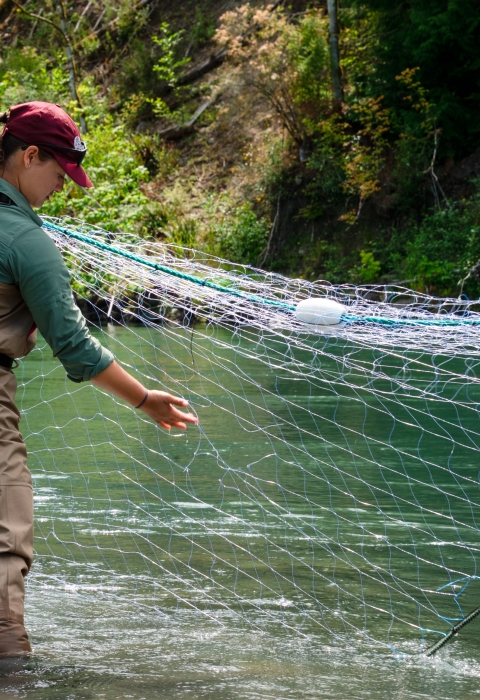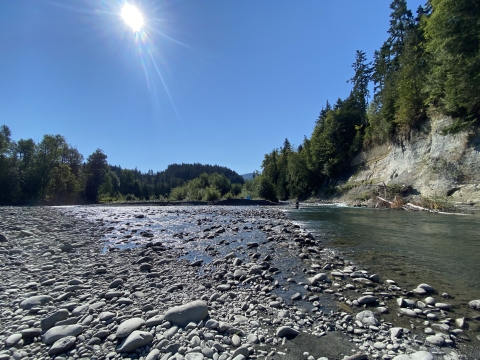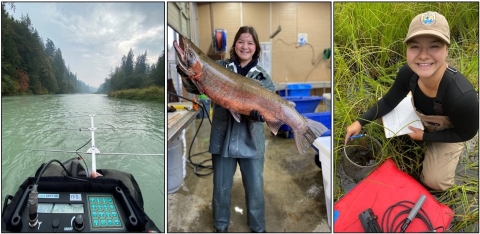My wading boots felt heavy on my feet, the oversized footies of my waders clunky inside them. I was waterproofed and ready as my official United States Fish and Wildlife Service hat shaded the bright sun from my eyes. After an early 6 am departure time and arduous drive down the winding roads of Highway 101, I was happy to be out of the car. I threw my heavy feet out of the truck, landing in the dewy grass and damp sand. I felt small surrounded by the cumulative experience and skill of the biologists and technicians around me, but I was eager to learn.
We walked down to the water like ducklings in a row carrying bags, data sheets, tape measures, tagging supplies and a bunch of other equipment I didn’t know the purpose of just yet. I followed closely behind our crew leaders as we combed through tree branches and waddled through the sand, unsure of our destination. My short stride and inexperience walking on river rocks made it difficult to keep up, but my excitement kept pushing me forward. Looking ahead, we broke through the shade of the bushes and creeped towards the edge of the water, and I was at a loss for words.
Various shades of blue blurred my vision and the sun reflected off every surface, blinding me for a brief moment. I couldn’t make out where the water ended and the sky began. The wind rushed through the narrow channel carved by the river and pushed my hat back so I could take in even more of my surroundings. I couldn’t believe that this is where I got to work — this was going to be my job for the next eight and a half months.
This first experience on the Elwha River was one of many highlights during my 8.5 months with the Service’s Western Washington Fish and Wildlife Conservation Office. Other highlights include a 30-mile raft float down the Nisqually River radio tracking salmon to identify spawning locations, rainy days sampling monstrous steelhead, and sorting hundreds of tagged hatchery fish, collecting their biological data for hatchery evaluation studies. Other exciting moments included mudminnow trapping up in Forks, Washington, where we were waist deep in lily pads, filling small cages with dog food to attract fish and a wide diversity of other critters. I have learned and grown a lot during the last 8.5 months exploring different river systems, coastal habitats, lake habitats, and streams — but where I feel I have grown the most was wading through and along the Elwha River.
The Elwha River in Washington’s Olympic Peninsula is renowned for hosting the largest completed dam removal project in the world to date. Recovery efforts and ecological monitoring projects have been ongoing since the final removal of the Elwha Dam in 2011 and the Glines Canyon Dam in 2014, and I have been fortunate enough to assist in some of the projects adjacent to these events.
Throughout multiple salmon runs, I assisted in marking and tagging adult coho, Chinook and steelhead. Radio tags and radiotelemetry played a huge role in the design and execution of this project. Once attached to the dorsal fin of the fish, the radio tags emit a radio signal that could be detected by our antennas and then translated into a certain noise by the receiver. The receiver would also display the tag number and information relative to the location of the fish and the strength of the radio signal.
Throughout the project we were responsible for tracking the fish as they continued their journey to their final spawning grounds in the upper Elwha River. I became familiar with wading through water, stumbling over river rocks and through trees all while holding that radio antenna, praying for the distinct clicking sounds that would indicate a tagged fish was nearby. It was exciting to locate and recognize a certain fish number and see how far it had moved upstream since the week prior.
By the end of the project, the Elwha River started to feel like a friend. It encouraged my confidence and ambitions as a scientist, gave me comfort and moments of peace during a hectic day, and inspired a passion for a river system I was just getting to know.
Throughout all these projects and hours spent on the water, I have truly discovered a passion for fisheries as a career path and gained more practical skills than I have in any other academic or professional period of my life. I plan to grow my skills and experience in the field over the next year until applying for graduate school where I will earn my masters in fisheries science. I hope to continue a career with the U.S. Fish & Wildlife Service where I can continue to work in incredible places supporting the preservation and recovery of threatened and endangered species.
Editors Note: Hannah's internship was through a partnership between the Western Washington Fish and Wildlife Conservation Office and the American Conservation Experience. American Conservation Experience is a non-profit organization dedicated to providing rewarding environmental service opportunities for young adults and emerging professionals of all backgrounds to explore and improve public lands while gaining practical professional experience.





